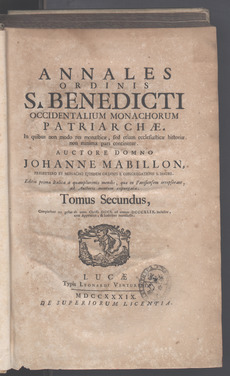Jean Mabillon facts for kids
Quick facts for kids Dom Jean Mabillon O.S.B. |
|
|---|---|

Dom Jean Mabillon, O.S.B.
|
|
| Religion | Roman Catholicism |
| School | Congregation of Saint Maur |
| Founder of | Palaeography and diplomatic |
| Known for | De re diplomatica |
| Personal | |
| Born | 23 November 1632 Saint-Pierremont, province of Champagne, Ardennes |
| Died | 27 December 1707 (aged 75) Paris |
| Resting place | Church of Saint-Germain-des-Prés |
| Parents |
|
| Senior posting | |
| Rank | Monk |
| Religious career | |
| Works | Acta Ordinis S. Benedicti |
Dom Jean Mabillon (born November 23, 1632 – died December 27, 1707) was a French Benedictine monk and a very important scholar. He is known as the person who started the study of palaeography and diplomatics. These are special ways of studying old writings and documents.
Contents
Early Life and Studies
Jean Mabillon was born in a small town called Saint-Pierremont in France. His father, Estienne Mabillon, lived to be 104 years old! When Jean was 12, he went to school in Reims.
In 1653, he became a monk at the Abbey of Saint-Remi. An abbey is like a monastery where monks live and work. He studied so hard that he became ill. To help him get better, he was sent to Corbie Abbey in 1658.
Later, in 1663, he moved to Saint-Denis Abbey near Paris. The next year, he went to the Abbey of Saint-Germain-des-Prés in Paris. This move was very important for him. It allowed him to meet and work with many other smart scholars.
Working with Old Texts
At Saint-Germain-des-Prés, Mabillon worked on editing the writings of Saint Bernard of Clairvaux. He also started a huge project to collect the life stories of Benedictine Saints. This collection was called Acta Ordinis S. Benedicti. It was published in nine large books over many years.
He worked on this project with another monk named Dom Luc d'Achery. Dom d'Achery was the librarian and had gathered many historical materials. Mabillon used these materials to write about the lives of the saints. He also used these stories to show what life was like in the early Middle Ages.
De re diplomatica: Studying Old Documents
In 1681, Mabillon published his most famous book, De re diplomatica. He wrote this book because some people were unsure if very old documents were real or fake. These documents were from the time of the Merovingian kings.
In his book, Mabillon looked closely at many different kinds of old documents. He studied their handwriting, their style, the seals on them, and the signatures. He also looked at other clues inside and outside the documents. He used his many years of experience to tell real documents from fake ones.
Mabillon explained that not all old documents are fake, even if some are. He wanted to create rules to help people tell the difference. He had spent almost 20 years reading and studying ancient writings and old records. He compared them to each other to build a strong knowledge base in this new field.
This important work made Mabillon famous. The King of France, Louis XIV, noticed him. Mabillon then traveled across Europe, visiting places like Flanders, Switzerland, Germany, and Italy. He was looking for old books and writings to add to the king's royal library.
Challenges and Support
Not everyone agreed with Mabillon's work. Some monks in his own abbey thought his studies were too academic. Another abbot, Armand de Rancé, believed Mabillon was spending too much time studying instead of doing manual labor.
Mabillon also caused some debate when he spoke out against honoring relics (old objects) from "unknown saints." He also wrote a critical review of some works by St. Augustine of Hippo. Some people even accused him of following a different religious idea called Jansenism. However, King Louis XIV and the Church always supported him.
Later Life and Lasting Impact
In 1701, King Louis XIV chose Mabillon to be one of the first members of a new important group called the Académie des Inscriptions et Belles-Lettres. In 1704, he published an update to his famous book, De re diplomatica.
Jean Mabillon passed away in 1707 and was buried in the church of Saint-Germain-des-Prés in Paris.
Many people consider Mabillon to be the greatest historical scholar of his time. His work helped create the modern way we study and understand old documents. The Mabillon subway station in Paris is named after him.
See also
 In Spanish: Jean Mabillon para niños
In Spanish: Jean Mabillon para niños
- Papal diplomatics
Images for kids




